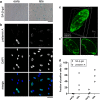Detection of mesenchymal stem cells senescence by prelamin A accumulation at the nuclear level
- PMID: 27625981
- PMCID: PMC5001959
- DOI: 10.1186/s40064-016-3091-7
Detection of mesenchymal stem cells senescence by prelamin A accumulation at the nuclear level
Abstract
Background: Human mesenchymal stem cells (MSC), during in vitro expansion, undergo a progressive loss of proliferative potential that leads to the senescent state, associated with a reduction of their "medicinal" properties. This may hampers their efficacy in the treatment of injured tissues. Quality controls on MSC-based cell therapy products should include an assessment of the senescent state. However, a reliable and specific marker is still missing. From studies on lamin-associated disorders, has emerged the correlation between defective lamin A maturation and cellular senescence.
Findings: Primary cultured hMSC lines (n = 3), were analyzed by immunostaining at different life-span stages for the accumulation of prelamin A, along with other markers of cellular senescence. During culture, cells at the last stage of their life span displayed evident signs of senescence consistent with the positivity of SA-β-gal staining. We also observed a significant increase of prelamin A positive cells. Furthermore, we verified that the cells marked by prelamin A were also positive for p21(Waf1) while negative for Ki67.
Conclusions: Overall data support that the detection of prelamin A identifies senescent MSC, providing an easy and reliable tool to be use alone or in combination with known senescence markers to screen MSC before their use in clinical applications.
Keywords: Cell- and tissue-based therapy; Lamin A; Mesenchymal stem cells; Prelamin A; Senescence.
Figures



References
-
- Caron M, Auclair M, Donadille B, et al. Human lipodystrophies linked to mutations in A-type lamins and to HIV protease inhibitor therapy are both associated with prelamin A accumulation, oxidative stress and premature cellular senescence. Cell Death Differ. 2007;14:1759–1767. doi: 10.1038/sj.cdd.4402197. - DOI - PubMed
-
- Crowe EP, Nacarelli T, Bitto A, et al. Detecting senescence: methods and approaches. In: Noguchi E, Gadaleta MC, et al., editors. Cell cycle control. New York, NY: Springer; 2014. pp. 425–445. - PubMed
LinkOut - more resources
Full Text Sources
Other Literature Sources

